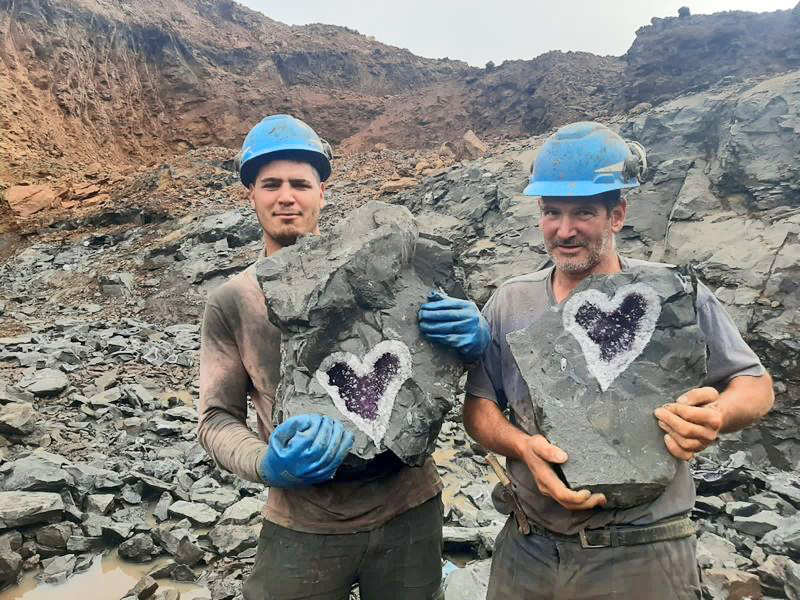
Credit: Uruguay Minerals–Marcos Lorenzelli S.R.L.
We’ve all seen geodes, and marveled at their beautiful crystal interiors, but do you know how they form?
Geodes occur mostly in lava and sedimentary rocks.
In molten lava, gas bubbles and lava tubes form, some quite large. They become voids as the rock hardens, and can fill with mineral-rich fluids. Over many years, minerals precipitate out, and crystals line the void. As more fluids seep in, more crystals grow.
Geodes that form in lava often contain quartz crystals, especially amethyst, which is quartz colored purple by iron impurities.
In sedimentary rock, pockets of mineral-rich water can crystallize in a similar fashion, sometimes with a translucent silica called chalcedony. When the sediment layers erode, geodes tumble out. The English call them “potato stones” for their telltale shape.
Because they’re often partially hollow, you can tell by weight that they may contain a geode. Those that fill completely with silica are called thunder eggs.
The world’s largest geode, as long as a school bus and tall enough to stand in, was found 20 years ago in Spain.
If you’d like to find your own potato stone or thunder egg, look for outcrops or road cuts on public land, take a shovel to sort through the eroded rubble – and look where others have found them before.
You may not find a world-record goliath, but you’ll enjoy the geologic Easter egg hunt!
Background
Synopsis: Geodes are lumpy hollow rocks that resemble potatoes, but they can contain colorful patterns and extraordinary crystals when cracked open. They get their start as fluid-filled cavities within volcanic and sedimentary rocks, developing crystalline rims or layers filling from the outside in as the fluid chemistry changes through time.
- Geodes are hollow subspherical rocks found in sedimentary and volcanic terrains that can contain colorful interiors featuring inward-pointing mineral crystals.
- Brazil, Uruguay, and Namibia are known for spectacular, large amethyst-lined geodes that form within extrusive volcanics, such as basalts.
- Sedimentary and volcaniclastic geodes are common in the American West in California, Utah, Nevada, and Arizona and in the Midwest, in states like Indiana, Iowa, Missouri, Illinois, Kentucky, and Tennessee.
- In volcanic regions, geodes may form in lava tubes or vesicles in basalts, or within stratified volcanic tuffs.
- Voids sealed within lava flows may have been filled with gases, hydrothermal waters or groundwater.
- Gases evolve from magma as it expands in response to lower pressures near Earth’s surface, sometimes creating a cavity in the lava.
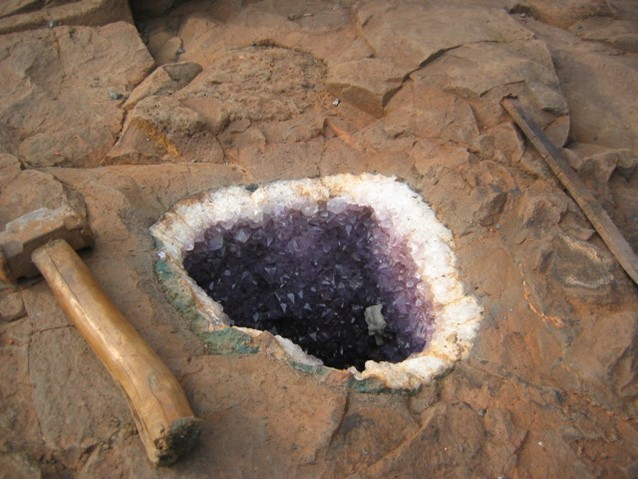
An amethyst geode within its volcanic parent rock.
Credit: MoRDi CuaC, CC BY-SA 2.0, via Wikimedia Commons - Lava tubes that initially acted as conduits for lava to move laterally away from eruption centers will eventually drain, leaving behind long tubes that may fill with crystals. We previously talked about lava tubes in ED-395 Living in Lava Tubes.
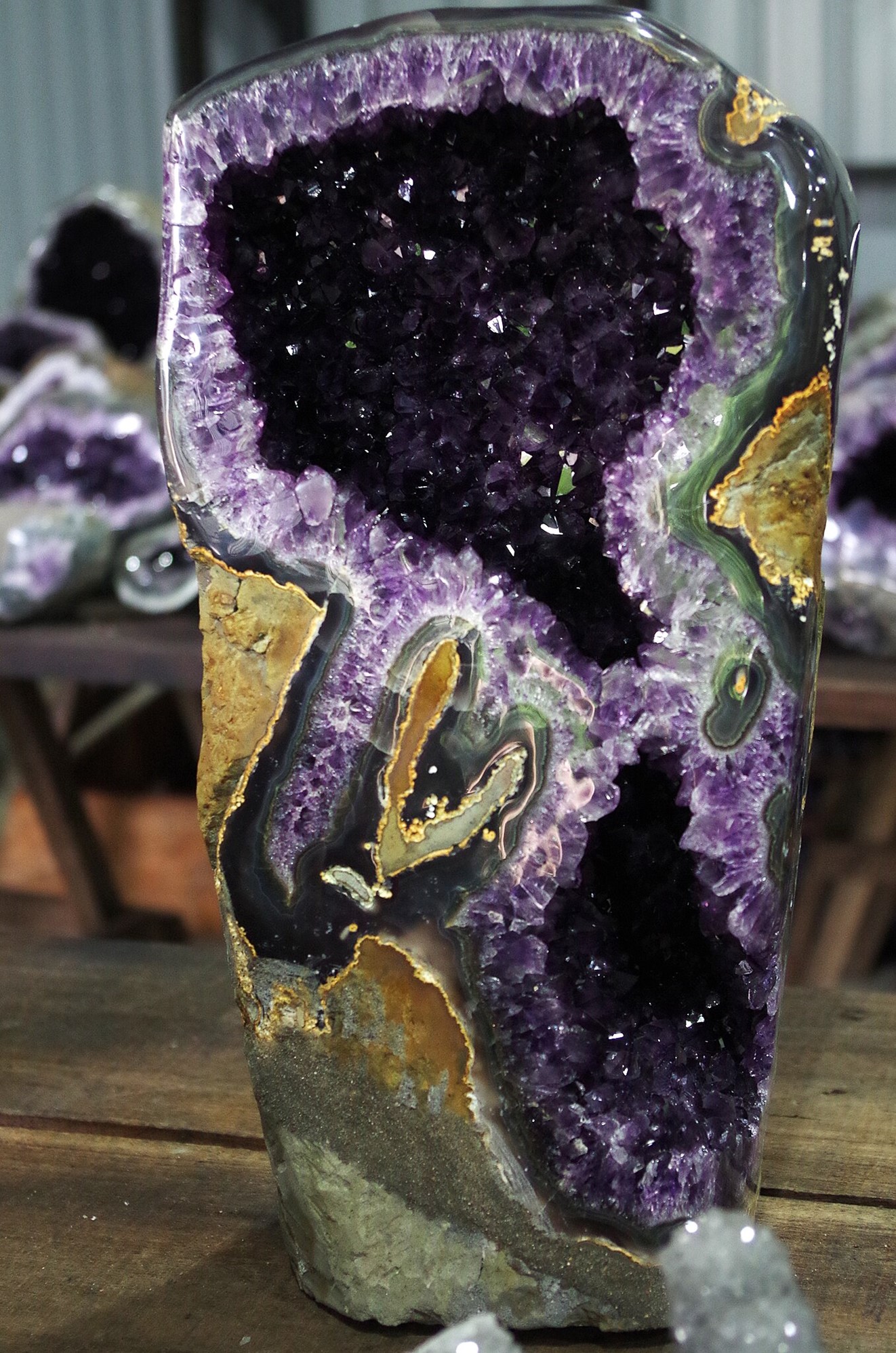
This large geode filled with deep purple amethyst was found within volcanic bedrock near the city of Artigas in Uruguay.
Credit: 7iago1990, CC BY-SA 4.0, via Wikimedia Commons - Many volcanic geodes are filled with large crystals of amethyst, a purple variety of quartz that is colored by iron impurities (Fe+3) within its crystal lattice.
- Some geodes from volcanic areas may preserve incredibly delicate crystals.
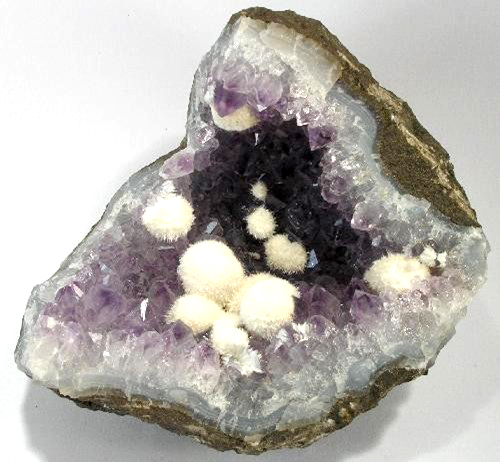
A geode containing balls of mordenite with very delicate needles that grew and were preserved in the void.
Credit: Rob Lavinsky–iRocks.com, CC BY-SA 3.0, via Wikimedia Commons - Agate geodes may form concentric rings or layers as silica-rich fluids migrate through geode cavities especially within volcanic tuff layers.
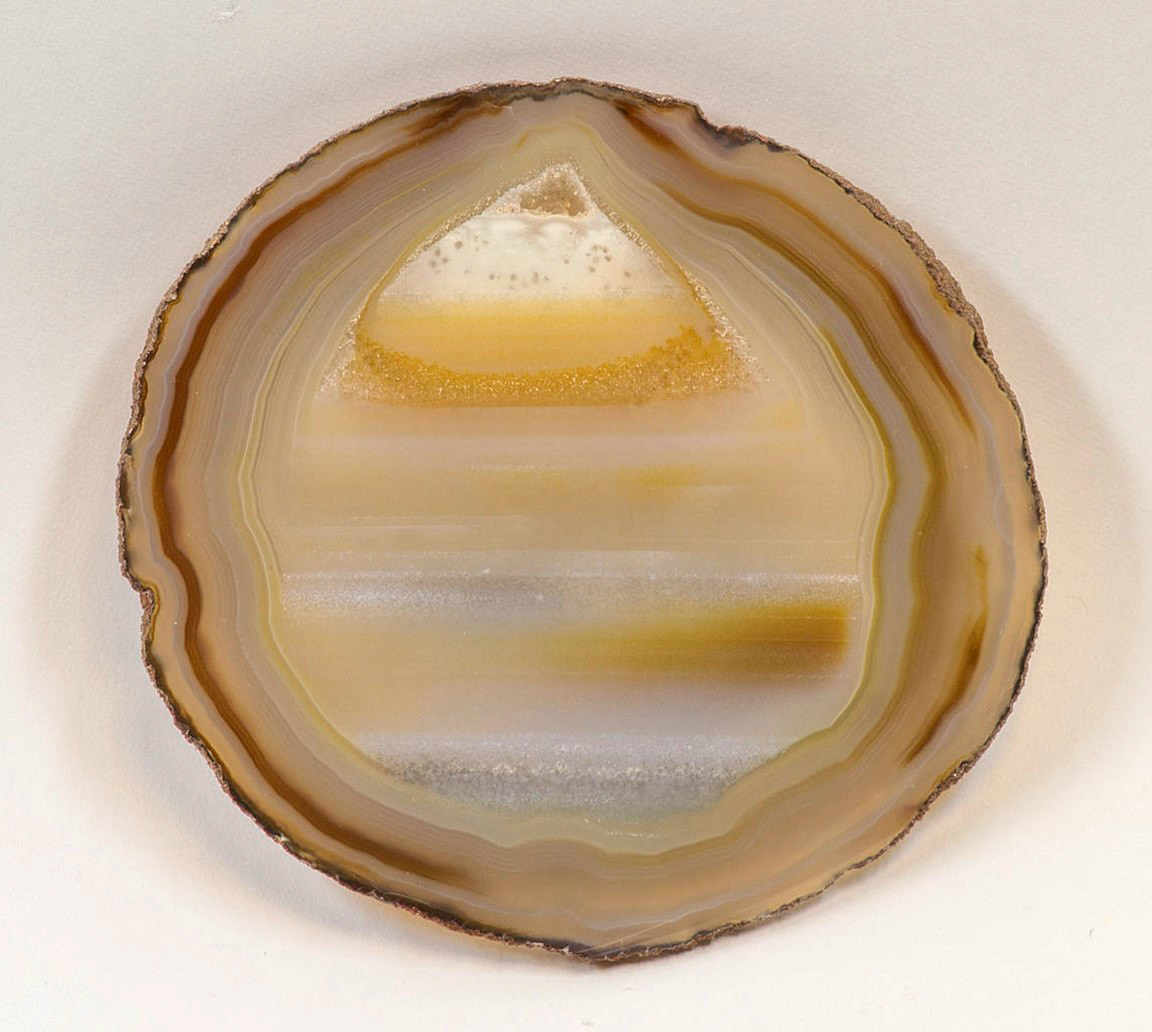
Agate forms from silica-rich fluids within a void. Deposition was concentric followed by a bottom-up sequence, with crystals forming in a tiny void at the top of the geode.
Credit: Hannes Grobe/AWI, CC BY 3.0, via Wikimedia Commons
- Geodes that form in sedimentary rocks are usually found in limestones, dolomites, limey shales or volcaniclastic ash beds.
- Sedimentary geodes are hard, roundish rocks with a mildly lumpy exterior that weather out of limestones or shales and generally range in diameter from 1-12 in (2.5-30 cm).
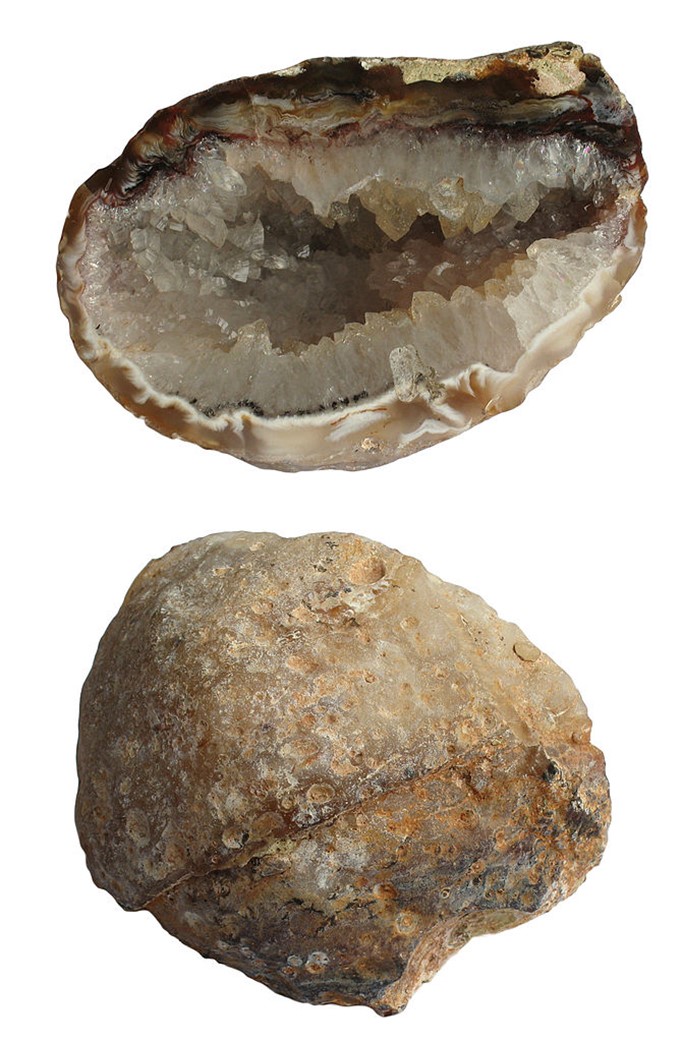
A quartz-filled geode, shown from inside (top) and outside (bottom)
Credit: I, Manfred Heyde, CC BY-SA 3.0, via Wikimedia Commons - They usually originate where organic material has decayed to leave a void.
- When forming, many sedimentary geodes expand their original cavity because of osmotic pressure differences that develop between internal and external waters with differing chemistry and salinity.
- Typically, a layer of silica gel forms at the outer periphery of the fluid. The gel dehydrates, crystallizing into an outer layer of fine-grained chalcedony.
- Younger layers of chalcedony may grow concentrically toward the interior of the void as it fills repeatedly with varying pore fluids or may form layers of agate.
- Geode crystals may form in gas filled voids over time, including quartz, calcite, or dolomite, and less frequently aragonite, ankerite, hematite, or magnetite. Sulfides like pyrite, chalcopyrite, and sphalerite may form the innermost crystals.
- Rocks that have formed in a similar fashion but are completely filled are usually called nodules or thundereggs.
- Do we want to mention the size of crystals and general relationship to precipitation time?
- Sedimentary geodes are hard, roundish rocks with a mildly lumpy exterior that weather out of limestones or shales and generally range in diameter from 1-12 in (2.5-30 cm).
- If you would like to go on a geode hunt, there are a few things you should know.
- While they are extraordinarily beautiful, large volcanic lava tube geodes filled with amethyst are generally difficult for amateurs to access since they are usually found on private property already owned by mining companies.
- Beautiful sedimentary geodes occur in more varied rock types and tend to be more accessible to the public. Be sure you are not on private property.
- One of the best strategies for a memorable geode treasure hunt is to visit places where they have been found in the past, in carbonate beds, volcanic ash badlands, and in lakebeds or riverbeds.
- Certain geographical areas tend to have geodes with specific mineral crystals, for instance Madagascar is famous for celestite geodes while Uruguay is famous for amethyst geodes.
- A sedimentary geode may look like a lumpy tan to grey potato, or maybe a cross between a potato and a cauliflower.
- In the Mendip Hills of Somerset, England they are called “potato stones.”
- Geodes are round or egg shaped and will be harder and more resistant to weathering than their host rock.
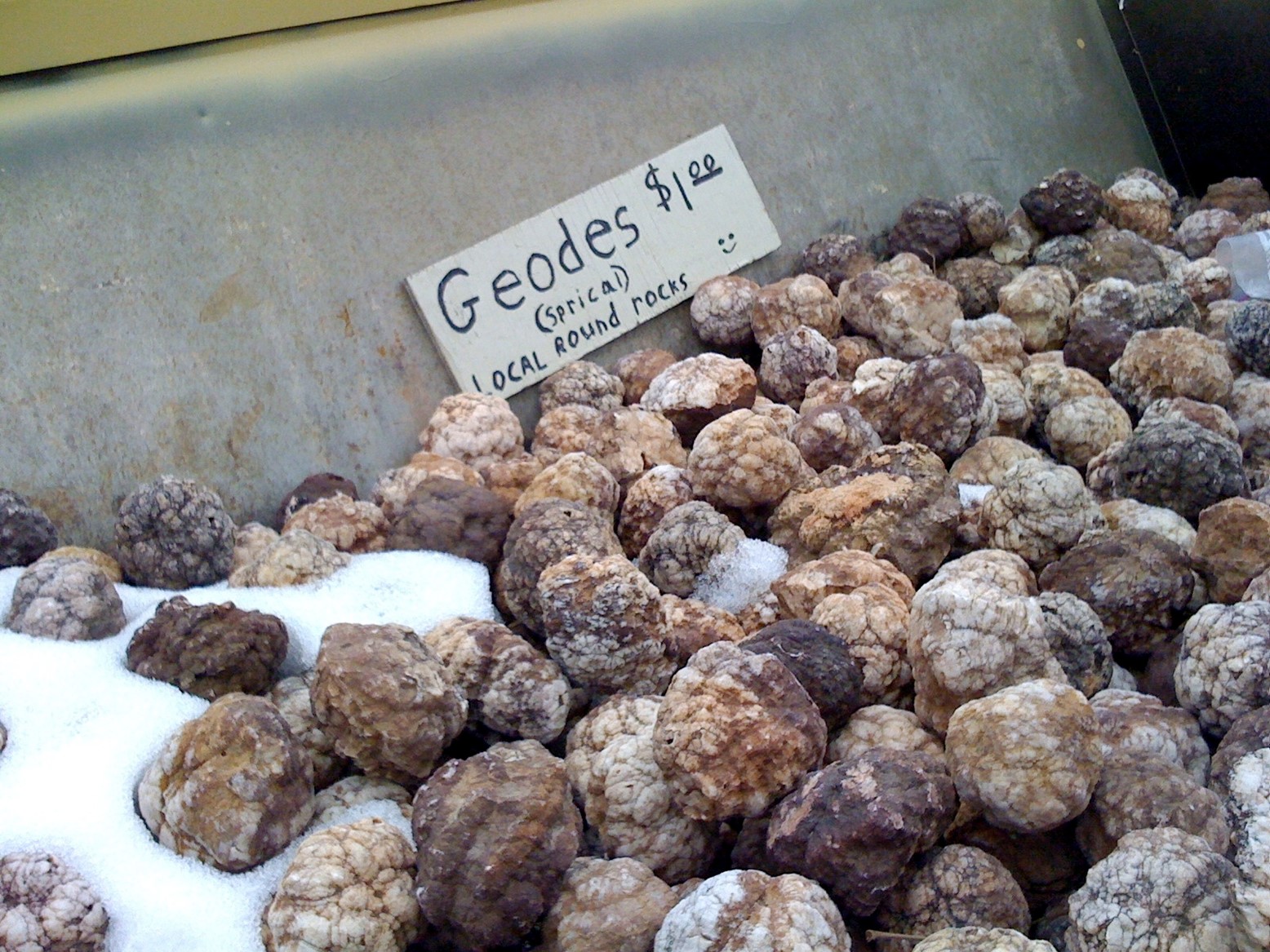
A pile of unopened geodes for sale in central Arizona.
Credit: cogdogblog, CC BY 2.0, via Wikimedia Commons - Sedimentary geodes weather out of their less resistant host rocks and may be found on the ground, in nearby stream beds, or residual soils.
- To find fresh geodes, you may have to dig into an outcrop or streambed with a shovel or trowel.
- Because they are hollow, geodes will weigh less than a solid rock, and some may even rattle. Heft the rock to compare its weight to other rocks.
- There are a variety of options for opening your geode.
- You can smash it with a heavier rock, but be careful not to splinter it beyond recognition.
- You can place it in a sock to keep the pieces together and hit it with a hammer.
- You can use a hammer and chisel to open it by making an indentation around the circumference of the rock where you would like it to break, then use the hammer to try to get a crack started, then carefully break it along the crack.
- You can saw it on a rock saw, or take it to a nearby rock shop and pay a small fee to have a professional cut it for you.
- One of Earth’s largest documented geodes is Spain’s Pulpí Geode with dimensions of 26 ft (8 m) long by 6 ft (1.8 m) wide, and an average height of 5.6 ft (1.7 m) high.
- It was discovered in an abandoned silver mine just 1.9 mi (3 km) from the Mediterranean coast in 1999.
- It is funnel shaped and formed in two phases, the first of which occurred when acidic waters dissolved the soluble dolomitic host rock.
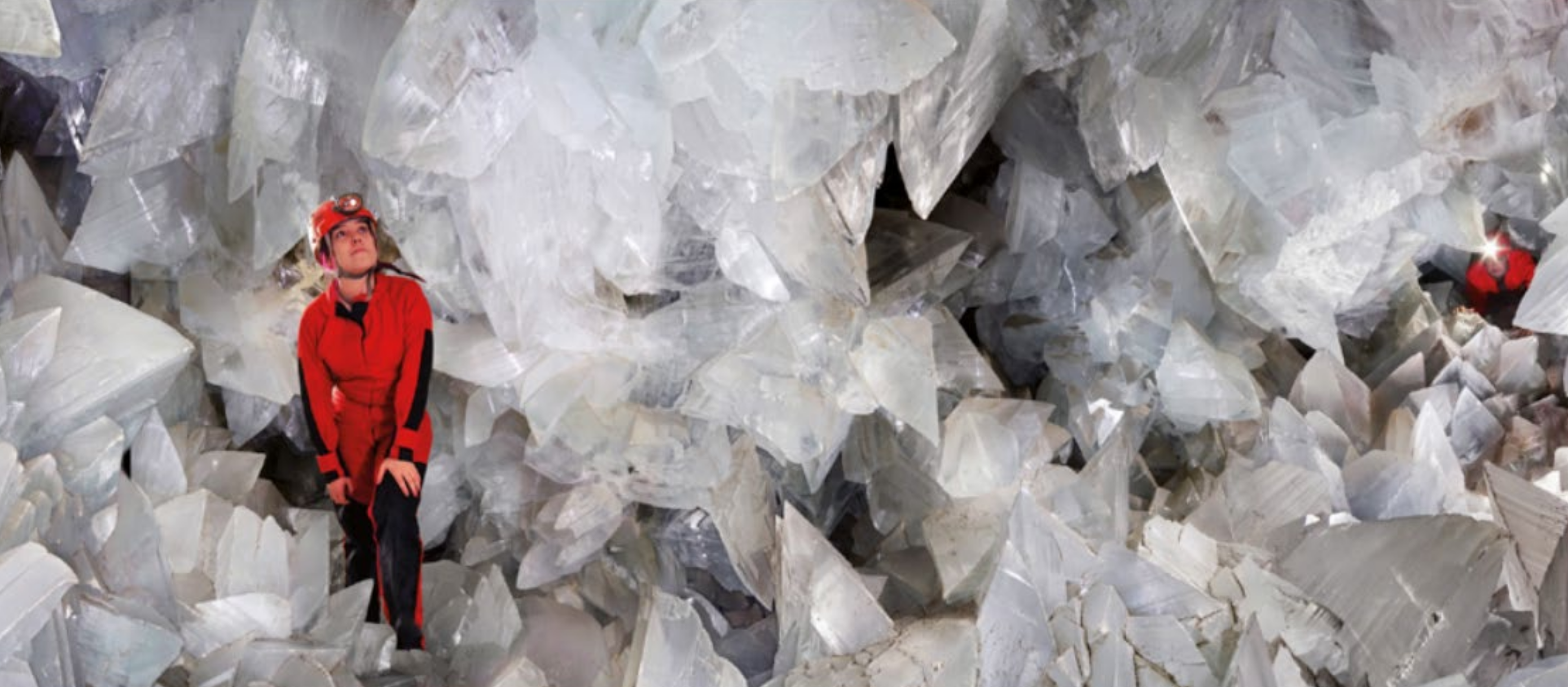
Scientists from the the University of Almería explore Andalusia’s gigantic Geoda de Pulpí near the Mediterranean coast of Spain.
Credit: Fernando Gázquez, Ana Monteserín, Christina Obert, Carsten Münker, Ángel Fernández-Cortés, José María Calaforra, CC BY 4.0, via Wikimedia Commons - It is lined with giant crystals of translucent selenite gypsum (CaSO₄·2H₂O) with lengths up to 6 ft (1.8 m) that are believed to have formed from chemical interactions within a Pleistocene freshwater aquifer that flowed through Triassic gypsum and anhydrite deposits between 165,000 and 60,000 years ago.
- The amazing crystal cave geode remains in place within the mine, which is now a geoheritage site that is open for geotoursim in groups of 12 with a guide.

